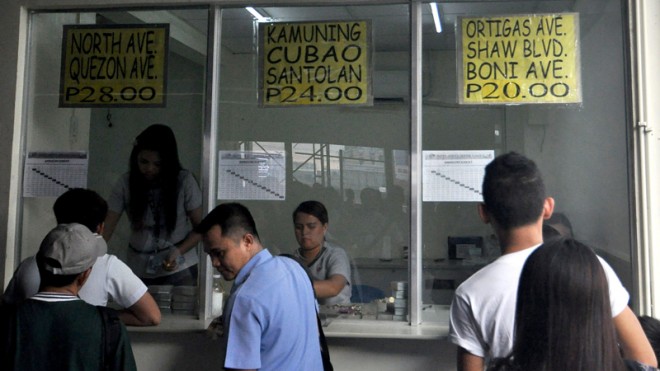What Went Before: MRT, LRT fare increases
On Jan. 4, fare increases in the two Light Railway Transit (LRT) systems and the Metro Rail Transit (MRT) were finally implemented after having been deferred several times. The decision to implement the MRT and LRT rate adjustments was reached on Dec. 18 last year.
Based on the fare matrices issued by the Department of Transportation and Communications (DOTC) and published in the Inquirer on Dec. 20, the new rates for end-to-end trips for the three lines are the following:
— LRT 1: P29 for stored-value fare and P30 for single-journey fare from the current P20 (from Baclaran to Roosevelt and vice versa).
— LRT 2: P24 for stored value fare and P25 for single-journey fare from the current P15 (from Recto to Santolan and vice versa).
— MRT 3: P28 from the current P15 (from North Avenue to Taft Avenue and vice versa).
Article continues after this advertisement“It’s a tough decision but it had to be made. It’s been several years since an increase was proposed. We delayed its implementation one last time until after the Christmas season. While 2015 will see increased fares, it will also see marked improvements in our LRT and MRT services,” Transportation Secretary Joseph Emilio Abaya said in a statement.
Article continues after this advertisementCut subsidies
The objective was to reduce about P12 billion in subsidies by about P2 billion, money the Aquino administration said would go to other social infrastructure and relief projects across the country.
Days following the fare increase, Bagong Alyansang Makabayan, former Iloilo Rep. Augusto Syjuco, Bayan Muna and United Filipino Consumers and Commuters Inc. petitioned the Supreme Court to halt the enforcement of the fare increases.
The petitioners contended that no public hearings were conducted for the rate hike as required by law and that only “public consultations” were held in February 2011 and December 2013 to inform the people about the rate increase.
They sought the issuance of a temporary restraining order, or a status quo ante order, against the increase, and the annulment of the Dec. 18, 2014, order of the DOTC approving it.
On Jan. 21, the government asked the Supreme Court to give it 30 more days to answer the petitions. In a motion, the Office of the Solicitor General asked the tribunal for a monthlong extension of what was supposed to be a “non-extendible period of 10 days,” citing the three-day holiday declared in Metro Manila for the recent visit of Pope Francis.
The pleading said the respondents needed more time to coordinate with the concerned agencies, which were all affected by the three-day holiday on Jan. 15, 16 and 19.
The fare increases were originally approved in January 2011, but President Aquino ordered the implementation deferred as prices of other key commodities rose at the time.
In October 2012, Abaya announced that fare increases in Metro Manila’s overhead train systems would likely take effect in 2013.
Abaya later said in a Senate hearing on his department’s 2013 budget that there would be no fare hikes until the services and facilities of the MRT and LRT had been improved.
In June 2013, Abaya said the long-overdue fare rise at Metro Manila’s three elevated rail systems could take effect as early as August that year as the government sought to recover part of its operating costs from the heavily subsidized train lines.
In December 2013, the DOTC released its proposed fare adjustments. Light Rail Transit Authority spokesman Hernando Cabrera then said the fares would increase by an average of P5 for an “average trip,” based on what he called the “11+1 formula”—a boarding charge of P11 plus P1 for every kilometer traveled.
The last fare increase for LRT 1 was in 2003, while LRT 2’s fares had not been adjusted before the Jan. 4 adjustments. Those for MRT 3 were lowered from P17 to P34 range in 1999 to P12 to P20 in 2000.–Inquirer Research
Sources: Inquirer Archives
